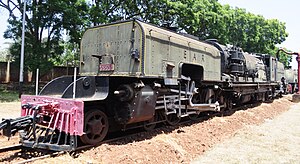KUR EC5 class
| |||||||||||
|---|---|---|---|---|---|---|---|---|---|---|---|
 5505 at the Nairobi Railway Museum, 2012 | |||||||||||
| |||||||||||
| |||||||||||
The KUR EC5 class was a class of 1,000 mm (3 ft 3+3⁄8 in) gauge 4-8-2+2-8-4 Garratt-type articulated steam locomotives built during the latter stages of World War II by Beyer, Peacock & Co. in Gorton, Manchester, England, for the War Department of the United Kingdom. The two members of the class entered service on the Kenya-Uganda Railway (KUR) in 1945. They were part of a batch of 20 locomotives, the rest of which were sent to either India or Burma.[1]

The following year, 1946, four locomotives from that batch were acquired by the Tanganyika Railway (TR) from Burma. They entered service on the TR as the TR GB class.[1]
In 1949, upon the merger of the KUR and the TR to form the East African Railways (EAR), the EC5 and GB classes were combined as the EAR 55 class. In 1952, the EAR acquired five more of the War Department batch of 20 from Burma, where they had been Burma Railways class GD; these five locomotives were then added to the EAR 55 class, bringing the total number of that class to 11 units.[1]
Class list
[edit]The builders and fleet numbers of each member of the EAR 55 class were as follows:[2][3]
|
See also
[edit]References
[edit]Notes
[edit]- ^ a b c Ramaer 1974, p. 64.
- ^ Ramaer 1974, pp. 70, 83.
- ^ Durrant 1981, pp. 189, 196.
Bibliography
[edit]- Durrant, A E (1981). Garratt Locomotives of the World (rev. and enl. ed.). Newton Abbot, England: David & Charles. ISBN 0-7153-7641-1. OCLC 9326294.
- Durrant, A E; Lewis, C P; Jorgensen, A A (1981). Steam in Africa. London: Hamlyn. ISBN 978-0-600-34946-4. OCLC 9014344. OL 15088099M. Wikidata Q111363476.
- Patience, Kevin (1976), Steam in East Africa: a pictorial history of the railways in East Africa, 1893-1976, Nairobi: Heinemann Educational Books (E.A.) Ltd, OCLC 3781370, Wikidata Q111363477
- Ramaer, Roel (1974). Steam Locomotives of the East African Railways. David & Charles Locomotive Studies. Newton Abbot, North Pomfret: David & Charles. ISBN 978-0-7153-6437-6. OCLC 832692810. OL 5110018M. Wikidata Q111363478.
- Ramaer, Roel (2009). Gari la Moshi: Steam Locomotives of the East African Railways. Malmö: Stenvalls. ISBN 978-91-7266-172-1. OCLC 502034710. Wikidata Q111363479.
External links
[edit]![]() Media related to EAR 55 class at Wikimedia Commons
Media related to EAR 55 class at Wikimedia Commons
- Beyer, Peacock locomotives
- East African Railways locomotives
- Garratt locomotives
- Kenya-Uganda Railway locomotives
- Metre gauge steam locomotives
- Railway locomotives introduced in 1945
- Steam locomotives of Kenya
- Steam locomotives of Tanzania
- Steam locomotives of Uganda
- Tanganyika Railway locomotives
- 4-8-2+2-8-4 locomotives
